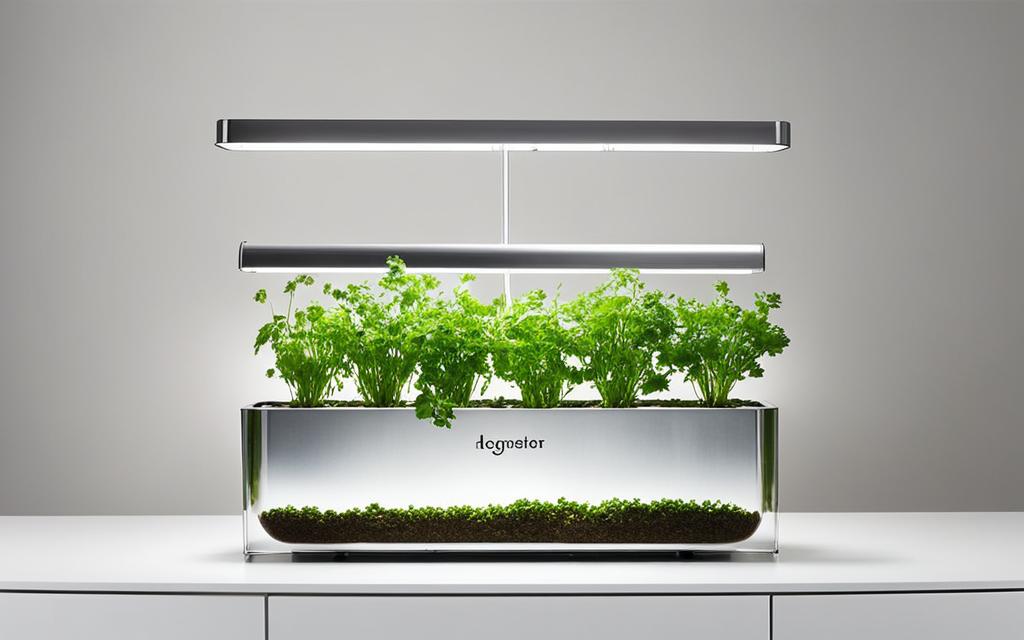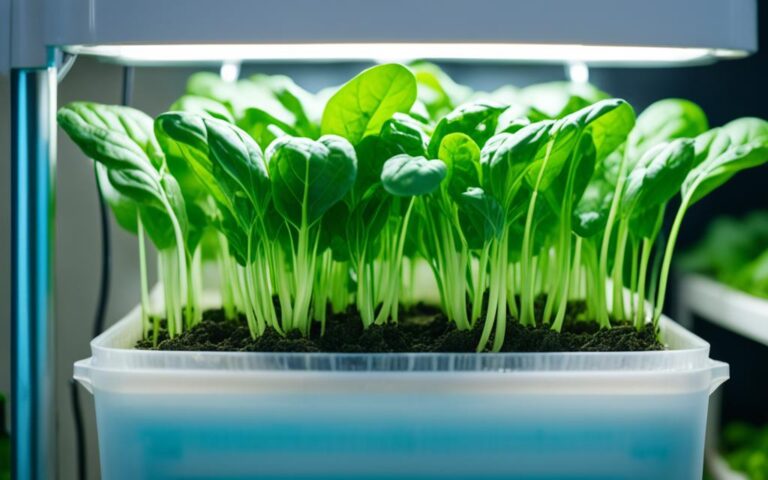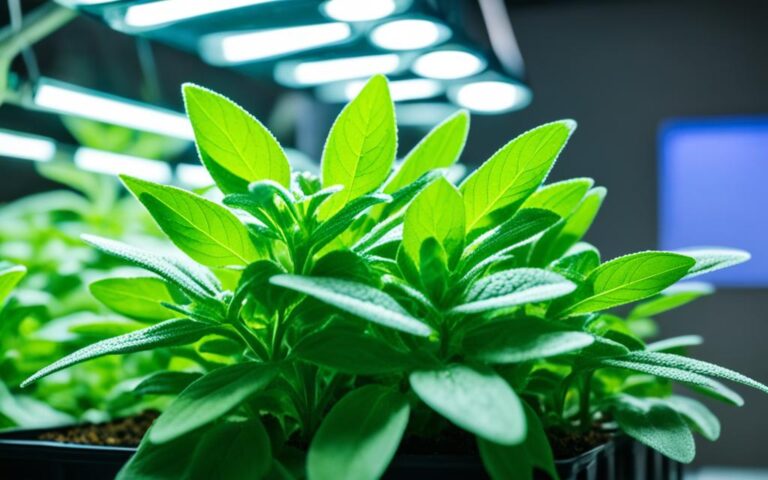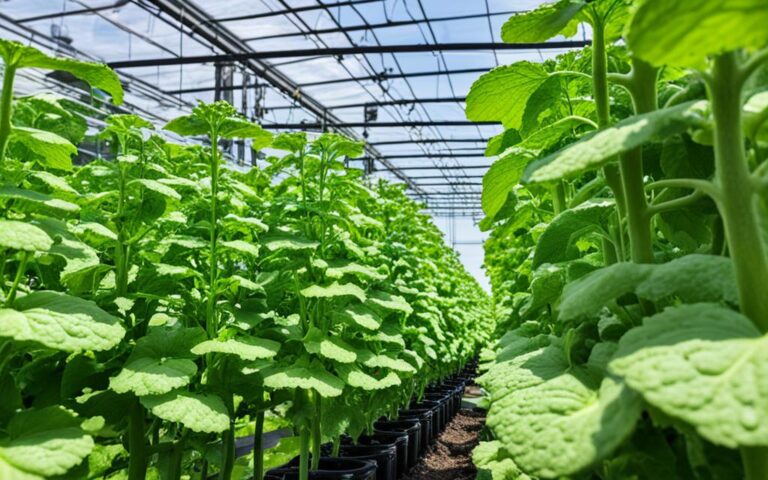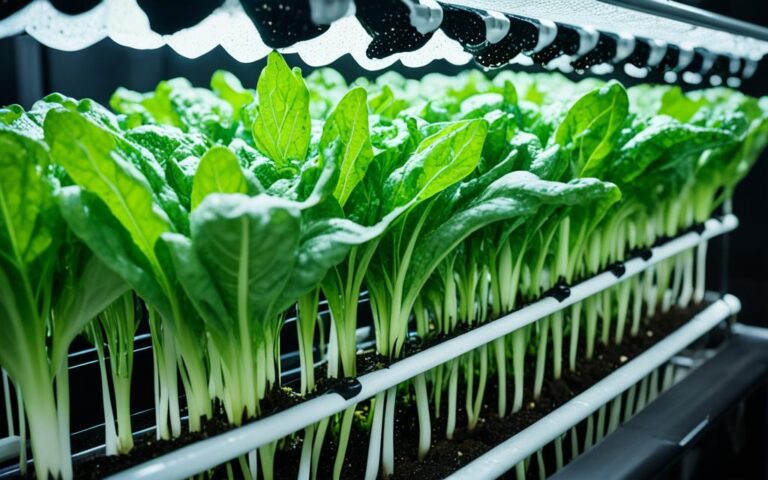Growing Hydroponic Cilantro: Tips for Success
Cilantro is a favorite herb known for its bright taste and many uses. It can do well in a hydroponic setup, letting you have fresh, fragrant leaves all year. Growing cilantro hydroponically is a green and easy way to get this herb indoors. You can control the conditions it grows in for a big harvest. This guide will show you how to grow hydroponic cilantro from seed to harvest, making your indoor garden flourish.
Key Takeaways
- Hydroponic cultivation lets you grow fresh cilantro all year, giving you a steady supply of this tasty herb.
- It’s important to manage light, temperature, nutrients, and pH levels for the best cilantro growth in hydroponics.
- Keeping pests and diseases away and harvesting regularly keeps your cilantro healthy and productive.
- Systems like Gardyn’s indoor gardening kits make it easy and automated to grow cilantro indoors with little work.
- Choosing hydroponic cilantro can lead to a sustainable, eco-friendly, and plentiful supply of this key kitchen herb.
Table of Contents
Introduction to Hydroponic Cilantro
Hydroponic cultivation changes the way we grow cilantro. It lets gardeners and farmers avoid the limits of traditional soil. This method allows for growing cilantro all year, more plants, and control over the growing conditions. It’s becoming popular for those wanting to grow this tasty and versatile herb.
Benefits of Growing Cilantro Hydroponically
Cilantro hydroponically has many benefits. It doesn’t need soil, so it gets a controlled, nutrient-rich place to grow. This means fast growth and longer harvest times. It gives a steady supply of fresh, tasty cilantro all year, meeting the needs of consumers and chefs.
Varieties Suitable for Hydroponic Cultivation
Some hydroponic cilantro varieties work really well. Here are some top picks:
- Calypso
- Delfino
- Slo Bolt
- Santos
- Orlando
- Slovenian
- Dwarf
- Lisbon
These plants grow well in hydroponic systems. They have compact growth and strong flavors. They’re perfect for growing indoors or outdoors.
| Variety | Characteristics |
|---|---|
| Calypso | Slow-bolting, dark green leaves, pungent flavor |
| Delfino | Finely cut, feathery leaves, distinctive aroma |
| Slo Bolt | Slow to bolt, excellent for continuous harvesting |
| Santos | Compact growth, high leaf yield, versatile flavor |
| Orlando | Uniform growth, vibrant green color, pungent taste |
Choosing the right Mexican cilantro hydroponic varieties is key. It helps growers get the most out of hydroponics and produce a steady supply of this loved herb.
Germinating Cilantro Seeds for Hydroponics
Cultivating hydroponic cilantro starts with getting the seeds to germinate well. Cilantro seeds can be tough to sprout, but the right methods help. One good way is the paper towel method. Here, seeds soak for 24-48 hours and then sit on damp paper towels to start germinating.
Another trick is to crack the seed husks gently before soaking them. This helps the seeds soak up more moisture and boosts germination rates. With care and the right conditions, cilantro seeds germinate in 7-10 days. Then, the leaves are ready for picking 40-48 days (5 ½ – 7 weeks) later.
To help your hydroponic cilantro seeds grow well, keep the temperature right during germination. Aim for a range of 68°F to 78°F (20°C to 25.5°C). This temperature is perfect for efficient sprouting, setting the stage for a great harvest.
“Successful seed germination is the first step towards a thriving hydroponic cilantro crop. With the right techniques, you can set your plants up for long-term success.”
After the best hydroponic cilantro seeds sprout, move them to your hydroponic setup. Make sure they get enough light, nutrients, and water to grow. Mastering seed germination leads to a bountiful harvest of fresh, tasty cilantro.
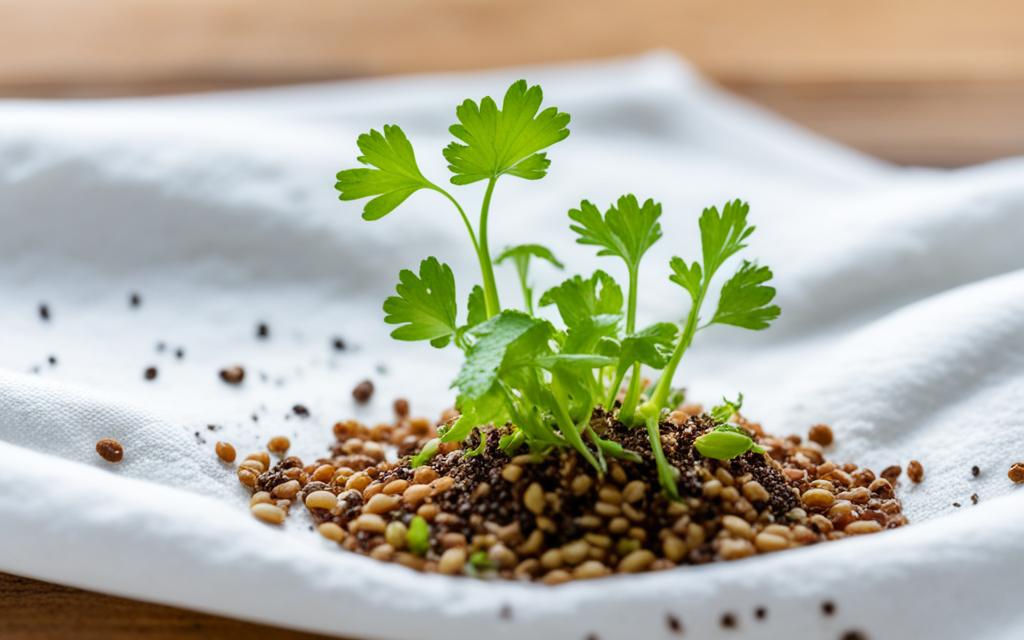
Choosing the Right Hydroponic System
When you want to grow cilantro hydroponically, you have many systems to pick from. Each system has its own benefits and things to think about. It’s key to pick the one that fits your growing needs and space.
Types of Hydroponic Systems for Cilantro
Popular hydroponic systems for cilantro include:
- Nutrient Film Technique (NFT): This system sends a steady flow of nutrient-rich water to the roots. It’s great for light crops like lettuce and spinach. The HydroCycle NFT Systems work well for cilantro too.
- Deep Water Culture (DWC): In DWC, the roots sit in a solution full of nutrients. It’s good for herbs, leafy greens, and bigger plants like peppers and squash.
- Ebb and Flow: This system floods the grow tray with solution, then drains it. It’s perfect for a variety of crops, including cilantro.
Think about space, budget, and how much automation you want when picking a hydroponic system for cilantro. Each system has its own perks. It’s important to research and pick the best one for you.
Considerations for Indoor Hydroponic Gardens
Indoor hydroponic gardens let you grow cilantro all year. But, you need to manage lighting, temperature, and humidity. Getting these conditions right is key for healthy cilantro plants.
| Hydroponic System | Suitable Crops | Key Considerations |
|---|---|---|
| Nutrient Film Technique (NFT) | Lettuce, spinach, berries | Ideal for lightweight plants, can be adapted for larger crops |
| Deep Water Culture (DWC) | Herbs, lettuce, squash, peppers | Provides consistent moisture and nutrient supply, can be paired with Aquaponics |
| Ebb and Flow | Peas, beans, cucumbers, cilantro | Suitable for a wide range of crops, enables larger yields and easy system modifications |
Knowing the different hydroponic systems and what to consider for indoor gardening helps you choose the best hydroponic system for cilantro. This way, you can have a successful and plentiful harvest in your indoor hydroponic gardens.
Water Quality and pH for hydroponic Cilantro
Keeping the right water quality and pH is key for healthy hydroponic cilantro. The best pH for cilantro is between 5.5 and 6.5. Also, the electrical conductivity (EC) or total dissolved solids (TDS) should be 1.5/800-1,000.
Use filtered tap water or distilled water for your plants. Test and adjust the pH and EC/TDS levels often. This helps your hydroponic cilantro grow well.
Importance of pH and EC/TDS Levels
The pH level affects how plants get the nutrients they need. If it’s too low or too high, it can cause problems like nutrient toxicity or deficiencies. Keeping it in the right range helps cilantro grow and develop well.
The EC or TDS level shows how much minerals and nutrients are in the water. For cilantro, the right EC/TDS range makes sure plants get what they need without too much or too little.
Monitoring and Adjusting pH and EC/TDS
- Check the pH with a pH meter or test kit often.
- Use acidic or basic solutions to adjust the pH as needed.
- Use an EC or TDS meter to keep levels right.
- Change the nutrient solution to keep the EC/TDS in check.
By controlling water quality and pH, you create the best environment for your hydroponic cilantro. This leads to healthy plants and lots of cilantro.
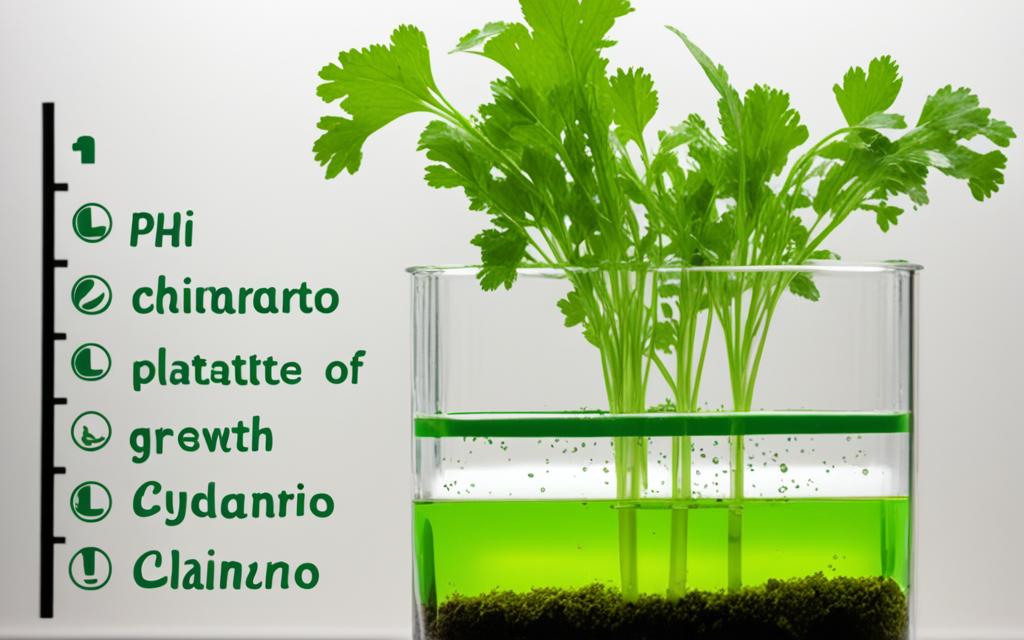
| Crop | Ideal EC (mS/cm) | Ideal pH |
|---|---|---|
| Basil | 1.0 to 1.6 | 5.5 to 6.0 |
| Cucumber | 1.7 to 2.0 | 5.0 to 5.5 |
| Tomato | 2.0 to 4.0 | 6.0 to 6.5 |
| Pepper | 0.8 to 1.8 | 5.5 to 6.0 |
| Lettuce | 1.2 to 1.8 | 6.0 to 7.0 |
Getting the pH and EC/TDS right is key for growing hydroponic cilantro well. By watching and adjusting these levels, you can make sure your cilantro thrives and gives you a big harvest.
Nutrient Solution for Hydroponic Cilantro
Cilantro grown in hydroponics needs a balanced nutrient solution. This solution must have the right mix of nutrients for the best growth. Cilantro loves a diet rich in nutrients, so picking the right fertilizer is key for tasty and healthy plants.
Essential Nutrients for Cilantro
Cilantro needs nitrogen (N), phosphorus (P), and potassium (K) as its main nutrients. It also needs iron, zinc, manganese, copper, boron, and molybdenum. A hydroponic formula with an N-P-K ratio of 10-5-14 is a good start for cilantro.
Cilantro also needs calcium and magnesium. These nutrients help make the plant’s cell walls strong and improve how well it takes in nutrients.
Preparing Nutrient Solutions
To make a nutrient solution for your cilantro, use a good hydroponic fertilizer or a special cilantro formula. Mix the nutrients as the instructions say. Make sure the solution’s EC or TDS is between 1.2-1.8 for cilantro.
Check and adjust the solution’s pH often. It should be between 5.5-6.7 for cilantro. Use pH up or down as needed.
With a balanced, well-prepared nutrient solution, your hydroponic cilantro will get the nutrients it needs. This ensures it grows well and gives you a lot of tasty cilantro.
Lighting Requirements for hydroponic Cilantro
To get a great harvest of hydroponic cilantro, you need the right lighting. Cilantro needs light for 12 to 16 hours a day. It does best with light that is 5,000 to 10,000 lux strong. This light should have both blue and red parts to help the plants grow well.
Light Intensity and Spectrum
Cilantro needs a lot of light to grow well. It likes 6 hours of sunlight a day, but some shade in the hot afternoon. High temperatures can make it bolt and change the taste of the leaves. In winter, it can handle more sunlight and a heating mat keeps it warm below 75°F.
For indoor setups, grow lights are great for mimicking the sun. White and yellow lights are best because they cover a wide area and give the right light. The Agrobrite light is a top choice for cilantro growers.
Photoperiod and Light Distance
Cilantro likes a day with less than 8 hours of light to stop it from making seeds too soon. Keep the grow lights 6 to 12 inches from the plants and use a timer for the light. This helps your cilantro grow well and gives you lots of it all year.
By controlling the light’s strength, color, and day length, you can make the perfect space for your cilantro. This leads to a steady supply of this tasty herb all year.
Temperature Control for Hydroponic Cilantro
Keeping the right temperature is key for hydroponic cilantro to grow well. The best temperature changes as the plant grows.
Optimal Temperatures at Different Growth Stages
When germinating seeds, keep the water warm, between 68°F and 77°F (20°C-25°C). For seedlings, the ideal temperature is 64°F-72°F (18°C-22°C). For mature plants, it’s best to keep the water at 59°F-68°F (15°C-20°C).
Bigger water tanks stay warmer and more stable than smaller ones. This means fewer temperature changes. In hot places, you might need a chiller to keep the water cool. In cold areas, a heater might be needed.
Good air flow is important, especially when the water is warm. Warm water has less oxygen, which roots need to stay healthy.
Keeping the right temperature is also key to stopping bad bacteria and algae. It affects how well plants take in nutrients, so you might need to adjust the nutrient solution.
Hydroponic setups like DWC, NFT, and Drip Systems help keep the water at a steady temperature. You can use insulation, air flow, temperature monitors, and recirculation to control the water temperature for cilantro.
By controlling the water temperature at each growth stage, you can make the best environment for your hydroponic cilantro. This helps the plants grow to their best.
Maintaining and Pruning Hydroponic Cilantro
Keeping up with maintenance and pruning is key for your hydroponic cilantro to grow well and produce a lot. By arranging and trimming your cilantro right, you get lush, full plants and more harvests.
Spacing and Trimming Cilantro Plants
Put your hydroponic cilantro plants 10-15 cm (4-6 inches) apart. This lets air move around them and gets water and nutrients to all. It stops them from getting too crowded and helps each plant grow well.
Trimming the outer leaves and taking out any that are yellow or damaged makes the plants grow more new, healthy leaves. Start trimming your cilantro when it’s 6 inches (15 cm) tall, which is about 60-75 days after you plant it. Cutting them back every week when they’re in bloom keeps them tasting good and keeps them producing.
- Space cilantro plants 10-15 cm (4-6 inches) apart for optimal growth
- Trim outer leaves and remove any yellowed or damaged foliage to promote new growth
- Start trimming plants when they reach 6 inches (15 cm) tall, typically 60-75 days after planting
- Prune plants weekly during the blooming period to maintain flavor and encourage continuous production
By using these hydroponic cilantro pruning and hydroponic cilantro spacing tips, you can keep your cilantro plants healthy, productive, and always ready with fresh, tasty leaves.

Pest and Disease Management
Keeping hydroponic cilantro healthy means watching out for pests and diseases. Cilantro grown in hydroponics can face problems like hydroponic cilantro pests like aphids, whiteflies, and spider mites. It can also get diseases such as mold, anthracnose, and root rot.
Common Pests Affecting Hydroponic Cilantro
Aphids, especially the Willow-carrot aphid, love to eat cilantro, celery, parsnip, and carrot. For high infestations, insecticides might be needed. But, some cilantro types can fight off these pests better.
Armyworms can also go after hydroponic cilantro, having up to 5 generations a year. Bacillus thuringiensis can be used to control them.
Cutworms, like Agrotis, Peridroma saucia, and Nephelodes minians, can harm many vegetables, including cilantro. Putting a barrier, like diatomaceous earth, around the plants can help keep cutworms away.
Preventing and Treating Hydroponic Cilantro Diseases
Hydroponic cilantro can get diseases like Pythium root rot, powdery mildew, Botrytis (gray mold), downy mildew, and Sclerotinia blight. Keeping the hydroponic setup clean and well-ventilated can stop these diseases from spreading.
If pests or diseases show up, use organic or biological controls to fix the issue. This might mean using OMRI-approved bioenzymes, biostimulants, mycorrhizae, and other natural substances. Biopesticides and things like Bacillus thuringiensis, pyrethrins, and endomycorrhizae can also help.
Using new tech in farming, like robots, monitoring systems, and AI, can help manage pests and diseases in hydroponic cilantro. This tech makes farming more precise and effective.
Harvesting hydroponic Cilantro
Growing cilantro hydroponically is rewarding when you start harvesting. You can get fresh, tasty leaves in about 40-50 days after planting. This way, you have a steady supply of this flavorful herb all season.
Techniques for Continuous Harvesting
For a steady harvest, use the “cut and come again” method. Just take off the outer leaves at the base, not the whole plant. This makes the plant grow more leaves, giving you more harvests.
You can also take the whole cilantro plant with its roots. This lets the plant regrow and give you more harvests. No matter the method, harvesting regularly and carefully is crucial for a steady supply of hydroponic cilantro.
The hydroponic cilantro growing time can change based on the variety, growing conditions, and how you harvest. But usually, from seed to harvest, it takes about 50-55 days.
“Consistent care, including pH management and nutrient application, is essential for healthy hydroponic cilantro growth.”
Knowing the best ways to harvest and the timeline for hydroponic cilantro helps growers get a lot of this herb all year.
Growing Cilantro Hydroponically Year-Round
Growing cilantro hydroponically lets you have it all year, even indoors. You can keep the right conditions for it to grow. This means you get fresh hydroponic cilantro all year, no matter the weather outside.
Hydroponic herbs grow better and produce more than those grown in soil. They do best in a temperature of 60-70 degrees Fahrenheit. It’s also key to keep the hydroponic solution’s pH between 5.5 and 6.5 for good nutrient uptake by hydroponic cilantro.
Herbs in hydroponics need a lot of light to grow well. They should get 14-16 hours of light daily. Keeping the humidity at 40-70% is also important. When you harvest, take no more than one-third of the plant to help it regrow.
The classic Cilantro (Santo Cilantro) is a great choice for year-round growth. Cilantro and Coriander are the same plant, but Cilantro turns into Coriander as it ages. Choose cilantro seeds that resist bolting well for better growth.
Cilantro doesn’t need a lot of nutrients, about 400ppm of fertilizer is enough. Starting Coriander seeds in the dark helps them germinate better. Transplanting them carefully is key to their success.
Use a 400ppm fertilizer mix with a pH of 5.6-6.5 for hydroponic cilantro. Popular systems for growing it include Flood and Drain, Top Feeding, and NFT. Many farms like single-layer NFT systems for even growth.
Keep the temperature below 75 degrees F to stop hydroponic cilantro from bolting. Once it bolts, it turns into Coriander. Cilantro grows in 60 to 75 days, needing a pH of 6.5 to 7.5 and an EC of 1.2 to 2.0.
Tips for Maximizing Hydroponic Cilantro Yields
To get a lot of cilantro from your hydroponic garden, you need to focus. Using a few key strategies can help you get more from your cilantro plants. This way, you can have a steady supply of this tasty, aromatic herb.
Starting with high-quality, disease-resistant cilantro seeds or seedlings is key. This gives your plants a strong start, helping them grow well and produce a lot. Also, making sure they get the right amount of nutrients, water, and light is important for a good hydroponic cilantro yield.
Keeping the temperature and humidity right is also crucial. Cilantro likes cooler weather, between 50°F and 75°F. Checking and adjusting these conditions can really help your maximizing hydroponic cilantro efforts.
Pruning and trimming your cilantro plants helps too. By taking off the older leaves, you encourage them to grow bushy and full. Just remember not to cut more than one-third of the plant at once to keep it strong.
Also, watch out for pests and diseases. Quickly dealing with problems like aphids, whiteflies, or powdery mildew keeps your cilantro healthy and productive.
“Consistent care and attention to detail are the keys to achieving maximum hydroponic cilantro yield in your indoor garden.”
By using these tips, you can make the most of your hydroponic cilantro setup. You’ll get a lot of cilantro all year round.
Conclusion
Growing hydroponic cilantro is a great way to have this tasty herb all year. It’s perfect for indoor gardening. By knowing what cilantro plants need, like how to germinate them and what hydroponic systems they like, you can grow a lot of cilantro leaves. This makes sure you always have fresh, high-quality cilantro for your cooking.
Using soilless growing for cilantro in a controlled environment agriculture system means you can control everything. This ensures you always have leafy greens available. With the right care, you can grow fresh cilantro at home or in a hydroponic setup. This helps make food production more sustainable.
Learning how to grow hydroponic cilantro lets you enjoy its flavor and aroma easily. It also helps you care for the planet. Plus, it shows how powerful indoor gardening and herb cultivation can be.
